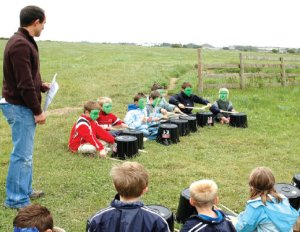Dylan Adams entered the museum world on a long-stay placement to work on schools projects, and found that music provided a way into understanding the past.

Music and museums are perhaps not always a happy pairing. Museums are traditionally visual places and a hushed quiet is preferred. However, the new curriculum encompasses emotional literacy, multiple intelligences, different learning styles including visual, kinaesthetic and aural. Experiential learning, learning across multiple subject areas, drama and movement are encouraged. This is backed up with hard scientific evidence from the realms of neuroscience. This is a call that is being answered not only in the classrooms, but in the National Museum of Wales in Cardiff too. Gwlad Y Gan, ‘The land of song’, is singing from the same hymn sheet.
Getting the children really to engage with archaeological displays is the goal, and music can do this in powerful ways. Music is the language of the emotions and well suited to expressing feelings. Moving to music produces dance, and, indeed, there are ancient cultures that do not use separate words for music and dance, believing you cannot do one without the other. This fact is particularly pertinent in a museum where ancient cultures are explored and presented. What better way to role-play a particular time and culture than to dance to the tunes of its time?
There is perhaps an even stronger way of using music to help us understand the past. Making music or composing (although I hesitate to use the word ‘composing’ because of the elitism it is often associated with) is a magical experience, and one we can all enjoy. It has been recently discovered that the brain is wired specifically for music, and if we dwell on this fact for a moment then it begins to open wonderful possibilities or even responsibilities in our minds. How better to get into the minds of our ancestors than to make up music using the same soundmaking devices (musical instruments) that they would have used and for the same rituals?
The freedom of my sabbatical enabled me to:
• Work with the Head and Music teacher at Ysgol Penysarn, Amlwch, to develop sound and music links for the Mynydd Parys Copper Kingdom story, creating a soundscape of newly composed music
• Use stories, thinking skills and philosophy as key workshop themes for children visiting the National Museum Cardiff
• Research Welsh legends and poems, adapting them as a way of bringing life to the Archaeology Galleries
• Develop strong links with artist and animator Sean Harris, director of an acclaimed film based on Welsh legend ‘The Hunt for the Twrch Trwyth’
• Plan how music could be used in the new Archaeology Galleries to accelerate learning, particularly for children with learning difficulties
• Liaise with tutors and students at University of Wales Institute, Cardiff about how music can deliver Education for Sustainable Development and Global Citizenship and how music can enhance the telling of Welsh legends
• Create sound and movement programmes for my Year 3 class at Archdeacon John Lewis Church in Wales Primary School for visits to Neolithic burial monuments in the Vale of Glamorgan.
All societies have used music to accompany ritual and help humans to express ideas and emotions. Funerals, parties, wars, bonding, weddings, laments: all humans have experienced feelings for the same sorts of things since we first began, and we do not need to be archaeologists to know this. Our heart beats to a rhythm, the world turns, animals sing, and for many religions the first act was a sound from God. Must museums sound like libraries? Perhaps I need to get in touch with some libraries!
Dylan Adams is a South Wales primary teacher on sabbatical with the National Museum of Wales in Cardiff.
t: 029 2039 7951;
w: http://www.museumwales.ac.uk/en/cardiff



